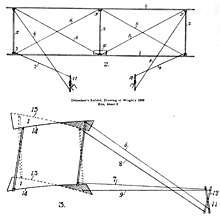Wing warping
Wing warping was an early system for lateral (roll) control of a fixed-wing aircraft. The technique, used and patented by the Wright brothers, consisted of a system of pulleys and cables to twist the trailing edges of the wings in opposite directions. In many respects, this approach is similar to that used to trim the performance of a paper airplane by curling the paper at the back of its wings.


Description
Birds visibly use wing warping to achieve control. This was a significant influence on early aircraft designers. The Wright brothers were the first group to use warping wings. Their first plane mimicked the bird's flight patterns and wing form.[1]
In practice, since most wing warping designs involved flexing of structural members, they were difficult to control and liable to cause structural failure. Ailerons had begun to replace wing warping as the most common means of achieving lateral control as early as 1911, especially in biplane designs. Monoplane wings of the period were much more flexible, and proved more amenable to wing warping – but even for monoplane designs, ailerons became the norm after 1915.
Lateral (roll) control in early aircraft was problematic at best. An overly flexible, involuntarily twisting wing can cause involuntary rolling, but even worse, it can convert attempts at correction, either from wing warping or ailerons, into a counteracting "servo tab" effect. Once this was fully understood, wing structures were made progressively more rigid, precluding wing warping altogether – and aircraft became far more controllable in the lateral plane.
Current technology has allowed scientists to revisit the concept of wing warping (also known as morphing wings).
Applications
Wing warping was a common feature of early aircraft, including:
- The Wright Flyer (1903)
- The Santos-Dumont Demoiselle (1907), the first homebuilt.
- The Antoinette V (1908), a wing-warping variant of the Antoinette IV
- The Blériot XI (1909), which made the first flight across a major body of water, namely the English Channel.
- The Etrich Taube (1910) originally used a cable-warped horizontal stabilizer to give elevator functionality as well
- The Nieuport IV (1911) racing and sport monoplane used for the first loop.
- The Bristol Coanda Monoplanes (1912), whose structural failures (along with those of a Deperdussin monoplane) led to a ban on monoplanes with the Royal Flying Corps.
- The early versions of the Royal Aircraft Factory B.E.2 (1912) used wing warping, while the "C" variant and later used ailerons.
- The Morane-Saulnier L (1913), the first fighter aircraft, and the first to shoot down another aircraft.
- The Morane-Saulnier N (1914), a World War I French scout derived from the previous G and H
- The Caudron G.4 (1915), a French biplane with twin engines.
- The Fokker Eindecker (1915), the first German fighter aircraft.
- The Fokker D.III (1916), one of the last operational fighters with wing warping.
- The Christmas Bullet (1919), whose wing warping and unbraced sprung steel spars contributed to its notoriety.
Modern re-assessment
Several of the reproduction planes built for the film Those Magnificent Men in Their Flying Machines used the wing warping control systems of the original aircraft – with mixed results. The wing warping of the Avro Triplane proved surprisingly successful, whereas on the reproduction Antoinette, with its very flexible wing, wing warping offered little effective lateral control. Since the original Antoinette-style ailerons would have probably been even less effective, unobtrusive "modern" ailerons were inserted – even with these, lateral control remained very poor.[2]
Wing morphing is a modern-day extension of wing warping in which the aerodynamic shape of the wing is modified under computer control. Research into this field is mainly conducted by NASA such as with the Mission Adaptive Wing (MAW) trialed from 1985 on a General Dynamics F-111 Aardvark.
Many major companies and scientists are working on developing morphing wings. NASA is working to develop a morphing wing made of cells that will twist to mimic birds. The cells NASA is using to construct the wing are small black modules consisting of carbon fiber. The wings will one day be able to form civilian airplanes that fly in any conditions. Currently, NASA is focusing on unmanned drones. [3]
Inman is another company working on morphing wings. Inman works with bird biologists in the hope of fully mimicking the animals flight patterns. Car companies have invested in Inman for applying wing morphing techniques to cars to make them more fuel efficient.[4]
See also
- Aileron
- M. P. W. Boulton, the British inventor (1868) of the aileron
- Elevon – a combination elevator/aileron used on Bleriot's earliest designs and more recently on flying wing and delta wing aircraft.
References
- "The Wright Brothers | Getting Acquainted with Aeronautics". airandspace.si.edu.
- Wheeler, Allen H. Building Aeroplanes for "Those Magnificent Men.". London: G.T. Foulis, 1965.
- "The 100-Year-Old Idea That Could Change Flight". www.pbs.org.
- "The 100-Year-Old Idea That Could Change Flight". www.pbs.org.
External links
- NASA – interactive diagram of wing warping used on the Wright Flyer
- Centennial of flight – illustration of Wilbur Wright invention of wing warping using a cardboard box
- Aerospaceweb – Origins of Control Surfaces
- PBS – What's Wing Warping?
- Flight demo of Owl's Head Transportation Museum's Etrich Taube reproduction, demonstrating warping wingtips and stabilizer